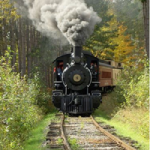
Several years ago I wrote an article titled, Is Your Golf Swing A Train Wreck? I consider it one of my better golf swing articles.
I’m hoping some of you still remember your train sets when you were young so I am going to use this as an analogy. Let’s compare an electric train traveling on a circular track to the golf swing through several experiments. I personally had a train set that could either be pulled by the engine or pushed by the caboose, and the passenger cars were linked together by metal clasps.
| 1 | When the engine pulls the train the links holding the cars together are pulled taut. When your body and left side in the golf swing unwinds your golf swing remains taut and controlled. |
| 2 | When the caboose pushes the train the links holding the cars together get jammed together. When your right shoulder pushes your golf club into the ball your swing becomes jammed, often causing a chicken wing left elbow through impact as well as causing your golf ball to push slice to the right. |
| 3 | When the engine pulls the train around the curve the cars have a tendency to lean outward with the last car wanting to whip. When your body unwinds the golf club has a tendency to pull outward with the trailing club head smashing through the ball. |
| 4 | If the train hits and obstacle in the track regardless if it is being pushed by the caboose or pulled by the engine the cars will pile up in a train wreck. If you stop your body from unwinding to hit at the golf ball with the right shoulder your golf swing will also result in a train wreck. |
| 5 | I believe the golf swing is powered by a pivoting rotary action with a stable base of support provided by the feet and legs. This action is similar to a hammer throw in track and field events. The hammer is pulling as the thrower is turning and opposing the hammer until its release. |

Rick Bradshaw
2004/2006 North Florida Section PGA Teacher of the Year
Director of Instruction, Dent/Bradshaw School of Golf
Heritage Isles Golf Club



